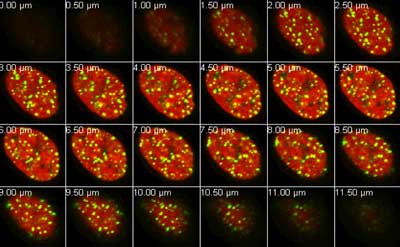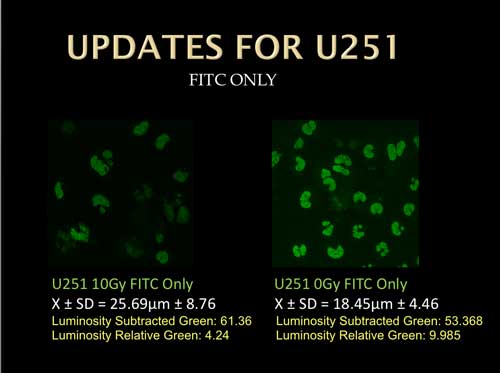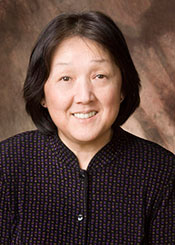Research in the Yasui Lab
Treatment of human brain cancer cells with neutron irradiation
 Human brain cancer or Glioblastoma multiforme (GBM) is one of the most aggressive and lethal forms of cancer. These cancers are not detected by the patient’s own immune surveillance system and the cancer cells will infiltrate normal brain tissue by growing unchecked in the patient. GBM is the most frequently diagnosed brain cancer in adults and by the time the patient is diagnosed with GBM, the prognosis is dismal. Survival is typically less than 1 year despite aggressive treatments that include surgery, high doses of conventional photon radiation (g rays or X-rays) and chemotherapy. Currently, without treatment, the patient will die; however, going through surgery and radiation and/or chemotherapy does not cure, it merely extends life for just a few more months. Recurrence rates are high because with the infiltrative growth pattern of the GBM, it is impossible to completely remove surgically. Subsequent treatment with high doses of conventional radiation to kill those tumor cells left behind after surgical resection also has a correspondingly high risk of damage to normal surrounding brain tissue. There is an urgent need to find a better treatment and cure for human GBM.
Human brain cancer or Glioblastoma multiforme (GBM) is one of the most aggressive and lethal forms of cancer. These cancers are not detected by the patient’s own immune surveillance system and the cancer cells will infiltrate normal brain tissue by growing unchecked in the patient. GBM is the most frequently diagnosed brain cancer in adults and by the time the patient is diagnosed with GBM, the prognosis is dismal. Survival is typically less than 1 year despite aggressive treatments that include surgery, high doses of conventional photon radiation (g rays or X-rays) and chemotherapy. Currently, without treatment, the patient will die; however, going through surgery and radiation and/or chemotherapy does not cure, it merely extends life for just a few more months. Recurrence rates are high because with the infiltrative growth pattern of the GBM, it is impossible to completely remove surgically. Subsequent treatment with high doses of conventional radiation to kill those tumor cells left behind after surgical resection also has a correspondingly high risk of damage to normal surrounding brain tissue. There is an urgent need to find a better treatment and cure for human GBM.
Our recent findings show that neutron irradiation is extremely effective at killing human brain cancer cells but in patients, a side effect of fast neutron irradiation, radiation inflammation or gliosis, kills patients. Radiation induced necrosis is a contributing factor to radiation induced inflammation but the role of necrosis in radiation induced cell death is not well understood. Understanding the role of radiation induced necrosis may reduce or eliminate the inflammation response and provide a therapy that could extend life or even provide a cure.
 My lab in biology is part of a multidisciplinary team whose common goal is to identify and more efficiently treat human brain tumors or GBMs. Such studies became possible when NIU took over the management of neutron therapy at Fermilab (now called The NIU Institute for Neutron Therapy or NIU-INT) in 2004. Of the handful of neutron therapy facilities in the United States, Fermilab has the highest energy beam. This high energy makes neutron dose delivery extremely efficient at eradicating tumor cells using lower doses of radiation. Members of this team include my basic cellular radiobiology lab at NIU (both graduate and undergraduate students participate in this project) and members of The NIU-INT at Fermilab. Members of the NIU-INT at Fermilab include medical doctors (radiation oncologists), medical physicists, radiation therapists and nurses. This arrangement facilitates scientific exchange between basic cellular radiobiology in my lab at NIU and the practical clinical experience at NIU-INT at Fermilab. Such a collaborative, multidisciplinary research approach provides an excellent “hand-on” learning experience for students with immediate practical implications in the treatment of human disease.
My lab in biology is part of a multidisciplinary team whose common goal is to identify and more efficiently treat human brain tumors or GBMs. Such studies became possible when NIU took over the management of neutron therapy at Fermilab (now called The NIU Institute for Neutron Therapy or NIU-INT) in 2004. Of the handful of neutron therapy facilities in the United States, Fermilab has the highest energy beam. This high energy makes neutron dose delivery extremely efficient at eradicating tumor cells using lower doses of radiation. Members of this team include my basic cellular radiobiology lab at NIU (both graduate and undergraduate students participate in this project) and members of The NIU-INT at Fermilab. Members of the NIU-INT at Fermilab include medical doctors (radiation oncologists), medical physicists, radiation therapists and nurses. This arrangement facilitates scientific exchange between basic cellular radiobiology in my lab at NIU and the practical clinical experience at NIU-INT at Fermilab. Such a collaborative, multidisciplinary research approach provides an excellent “hand-on” learning experience for students with immediate practical implications in the treatment of human disease.
Linda S. Yasui
lyasui@niu.edu
815-753-3521 (O)
815-753-3305 (L)
Office: MO 358, Lab: MO. 114
Dept. of Biological Sciences
Northern Illinois University
DeKalb, IL 60115-3521
